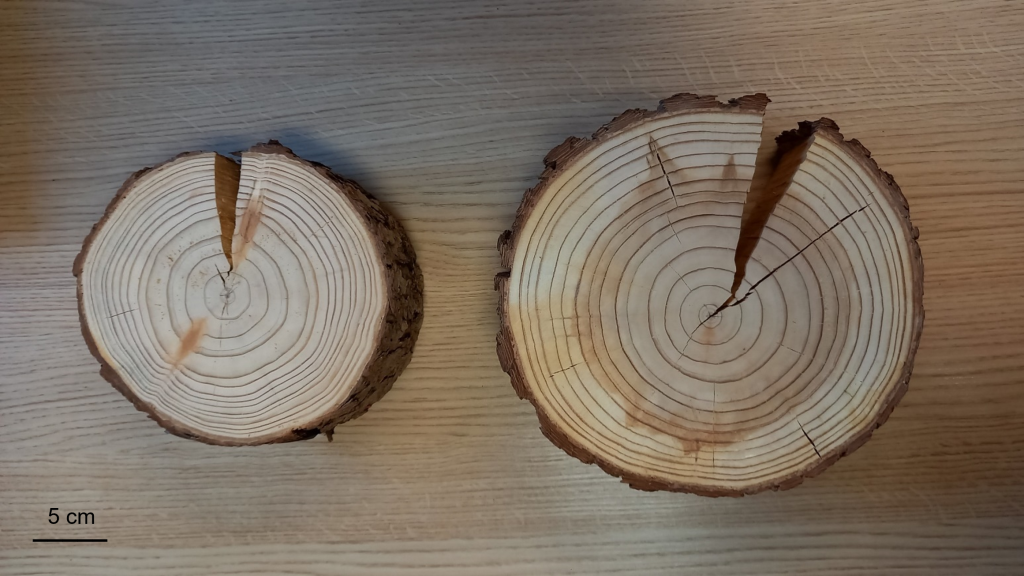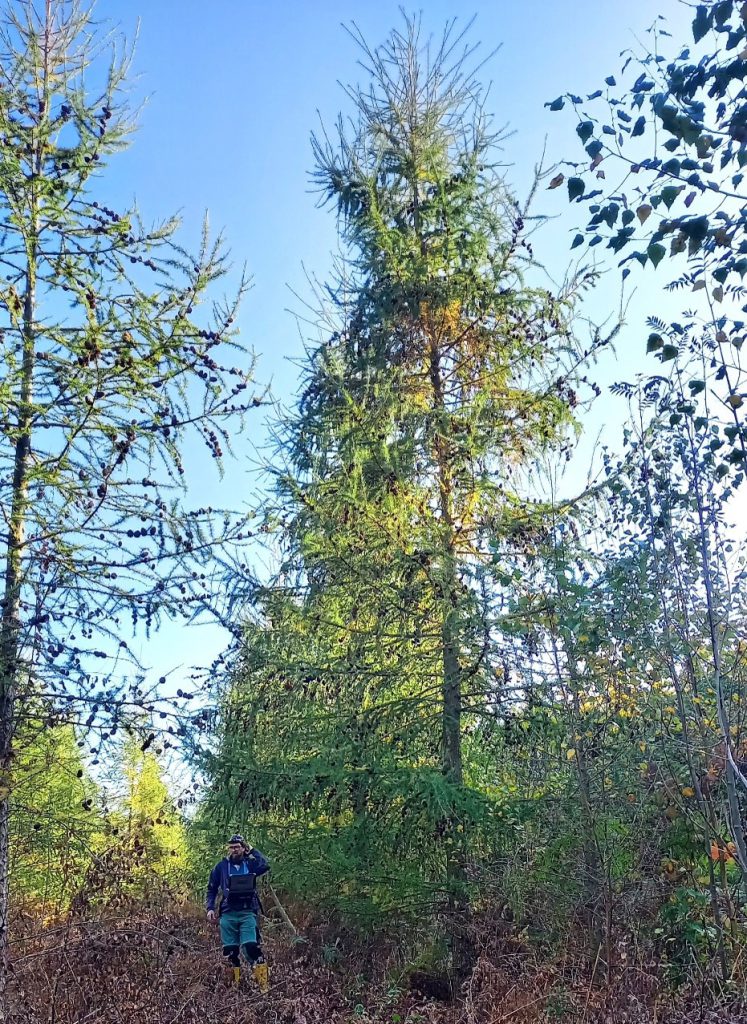
SHORT & CONCISE
PORTRAIT
Name: Titan Larch® (European Hybrid Larch, Larix × eurolepis)
Delivery size: 20-50cm
Quality delivery: 1-year-old, with root ball

SHORT & CONCISE
Name: Titan Larch® (European Hybrid Larch, Larix × eurolepis)
Delivery size: 20-50cm
Quality delivery: 1-year-old, with root ball
The Titan Larches are hybrids resulting from controlled crosses between approved parent trees of the European larch (mother, Larix decidua) and the Japanese larch (father, L. kaempferi). These crossbreeding combinations have been developed at the Forest Genetics Breeding Institute in Graupa since the 1950s. A number of Titan Larch clones are currently undergoing testing to be approved as forest reproductive material in the "Tested" category. The clone assortment grouped under the name Titan Larch surpasses the parent species in vitality and growth performance, without compromising the valued wood properties.
Additionally, Titan Larches are more drought-resistant and exhibit a comparable or superior stem form compared to their parent species, which enhances wood quality and thus their economic value. For optimal growth results, they require light-exposed sites on deep soils, as they are a light-demanding species. Their propagation is achieved through somatic embryogenesis without genetic modification.
Initially conical, later moderately broad crown, branches rising at the tip, reddish brown bark later grey-brown and deeply furrowed
Rapid growth (especially in youth)
Deep-reaching taproot
Bei Titan-Lärchen ist eine mittlere Baumhöhe von 20 m innerhalb von 30 Jahren möglich.
Large ecological amplitude, very site-tolerant
No special requirements for nutrient supply
Waterlogged soils are unsuitable for successful cultivation
Larches are true light-demanding tree species, meaning they are sensitive to shading; however, their crowns are very light-permeable
Preferred in early spring before needle emergence (March) or after needle discoloration (November)
On short shoots in dense clusters, flat on the upper side, narrow
1.5 – 3 cm long
Bluish green, golden yellow in autumn
Deciduous tree species
5 to about 10 mm long, cone-like, oval to spherical, downward-curved yellowish-brown catkins (male) or upright pink to dark red or purple cones (female)
Blooming in March/April before needle emergence
Distinctive reddish-brown heartwood, clearly separated from the light yellow to reddish sapwood
Well-visible growth ring boundaries
High durability and weather resistance of the heartwood
Versatile, e.g. as construction timber, furniture, windows, flooring, shingles
One of the most valuable softwood timbers
A sensible alternative to tropical woods for outdoor use
Despite higher growth performance, the wood characteristics of the Titan Larch are on par with those of the European Larch

Comparison of the diameters of European Larch (left, Ø 19.5 cm) and an elite clone of the Titan Larch under suitable conditions (right, Ø 24.5 cm) at the age of 19 years. Despite the significantly higher growth performance of the Titan Larch, there are no differences in wood properties compared to the European Larch.
As a robust pioneer tree species with high late frost tolerance, it is primarily suitable for cultivation on open areas, initial or reforestation projects.
Die TITAN-Lärche ist in ihren Anforderungen an die waldbauliche Behandlung zur Europäischen- und Japanischen Lärche identisch und besitzt bei konsequenter waldbaulicher Behandlung großes Wertholzpotenzial.
Artificial regeneration with 2500 – 3300 plants per hectare, in clusters or small stands (at least 0.3 ha), also well-suited for dry and/or exposed sites.
Well-suited as an intermediate forest generation after the loss of the upper stand to protect a frost-sensitive pre-crop, i.e., as a forestrial, fast-growing canopy for shade-tolerant species such as White Fir or European Beech.
For establishing a pre-forest on calamity areas with a pronounced open-area climate, 1000 plants per hectare are recommended.
Also highly suitable for planting in clumps, groups, or clusters in larger open areas of at least 0.3 ha in size, which are either not shaded or only lightly shaded, within the natural regeneration of other tree species or as advance regeneration in gaps.
Preferred establishment in a mix involving soil-improving hardwoods such as European Beech in the understory, to avoid the formation of unfavorable humus types due to the relatively poor decomposability of larch needle litter.
As a light-demanding tree species, the Titan Larch, like all larch species, requires early and regular space regulation and thinning. The goal is to create enough growing space for the best trees (future or Z-trees) to develop a green crown covering about 50% of the total tree height.
This is done through high thinning starting at a top height of approximately 10 to 12 meters, with about 100 Z-trees per hectare being promoted by the regular removal of competing trees (every 5 years).
Only when the top height reaches approximately 20 to 22 meters is the thinning interval and its intensity reduced – provided that the Z-trees are sufficiently qualified within a stable stand.
To optimally utilize the site’s productive capacity, regeneration is initiated at an age of approximately 40 years, through the pre-cropping of White Fir and European Beech.

The yield potential of the European Larch compared to other main tree species is given based on total growth performance, measured in stock cubic meters (Vfm) per hectare up to the age of 40 years. Only the wood stock of a standing tree above the solid wood threshold of 7 cm DBH is considered. Due to the higher growth performance of the Titan Larch, significantly higher values are possible here.
Erzeugung von schwachem Stammholz im Kurzumtrieb, d.h. eine frühzeitige Möglichkeit zur Erzielung von Holzerlös ist je nach Standortgüte bereits innerhalb von 30 bis 45 Jahren durch Entnahme des TITAN-Lärchen-Vorwaldes gegeben.
With a longer production period of about 50 to 80 years, both stronger sawtimber from a diameter at breast height (DBH) of about 45 cm and high-value timber from a DBH of about 60 cm are possible.
Wertholzerzeugung setzt jedoch eine frühzeitig beginnende Astung ab einem BHD von ca. 10 bis 15 cm der besten Z-Bäume auf mindestens 6 m Schaftlänge voraus.

11-jährige TTITAN-Lärche vermehrt durch somatische Embryogenese (BHD 17 cm) auf einer Wiederaufforstungsfläche nach Kalamität.
Source and further information
Schütt, P., Weisgerber, H., Lang, U., Roloff, A., & Stimm, B. (2006). Encyclopedia of Woody Plants.

Documentation: Wood for Industry, wood from fast-growing breeding products – from external to internal values
Download size: 2 MB